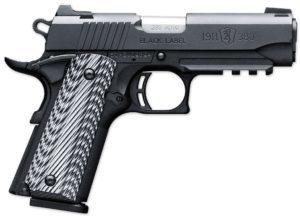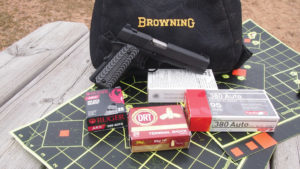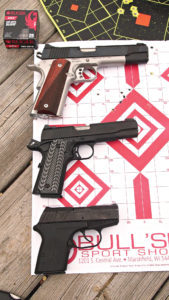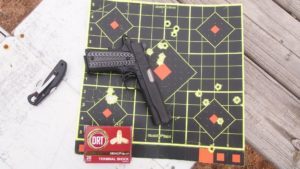The slim, trim design of the Browning .380 Auto Black Label Pro offers good concealment for everyday carry, and won't thump you at the range. (Photo: Brian McCombie)
In 2015, Browning Arms debuted its Black Label 1911-380, an 85 percent scale model of John Browning’s original 1911 design and chambered it in .380 Auto. The positive response to the nifty little 1911 caught even Browning somewhat by surprise.
“They sold very well right from the beginning,” said Aaron Cummins, firearms product manager for Browning. “Even with switching as much capacity to that product as we could? We still could not keep up with the demand.”

Browning's Black Label 1911 .380 Pro Compact with rail for accessories. (Photo: Browning)
Browning has added two versions to the Black Label line, the Black Label 1911-.380 Pro and Black Label 1911-380 Pro with Rail. The two new models are more “tactical” than the original, and are available with either steel three-dot combat sights or night sights. The Pro model with the rail allows a user to easily attach a light or laser to the underside of the barrel.
The grips on both models are made of G-10 composite. The rust-resistant barrel is 4¼-inches long and includes a target crown. Each pistol has an extended, ambidextrous manual thumb safety, extended slide release and beavertail grip safety.
I received a 1911-380 Pro and, after several range sessions, I can see why Browning found itself with more demand that it had production capacity. It’s a fine pistol with many applications, and among the most accurate .380s I’ve ever used. Like the original model, the Black Label 1911-380 Pro should appeal to a wide variety of shooters, including 1911 aficionados and concealed carriers. It will also be attractive to those shooters with smaller hands who would like a 1911 platform pistol, but find the full-sized models too bulky for a secure grip.

Today’s .380 Auto self-defense rounds are much more powerful and effective than they’ve ever been. They drive deeper and expand much larger than .380s on the past. (Photo: Brian McCombie)
I love 1911s, own a couple and am fortunate enough to try out many others for reviews, such as this one. So the first thing I noticed with the Black Label Pro was it felt very different in hand than any other 1911 model pistol I’ve shot. That’s not surprising, given its smaller size compared to full-sized 1911s. But it did take some time and practice before I was able to make the needed adjustments.
For example, I initially held the Black Label Pro with the same standard 1911 grip I always use. The biggest problem was the thumb on my non-shooting hand was right on the left side of the slide, not beneath it. When I adjusted my grip so that my left thumb and fingers sat below the slide, I then had a shooting hand situation; the web of my thumb wasn’t pushing on the grip safety hard enough to allow me to fire the pistol.
OK, so some changes were required. What worked best for me was to get a firm grip with my shooting hand, but with my thumb lower on the grip than I would with other 1911s, and then place my non-shooting thumb over my shooting thumb.

Three handguns, size comparison. From top to bottom, full sized Kimber 1911 Custom Two Tone .45 ACP, Browning Black Label, and Remington RM380 in .380 Auto. (Photo: Brian McCombie)
At the range, I used four different brands of .380 Auto ammunition to test the Black Label Pro: Aguila, firing a 95-grain FMJ bullet; Dynamic Research Technologies (DRT), 85-grain frangible hollowpoint; Remington UMC, 95-grain full metal jacket (FMJ); and, the new Ruger ARX with a 56-grain copper-polymer bullet.
Given the rather small .380 caliber and that caliber’s limitations, I did all my accuracy testing at 10 yards shooting offhand. And I was impressed.
My best five-shot group measured .706 inches, as measured by my Tool Shop Stainless Steel Digital Caliper, and was achieved with the DRT. Best four-shot group was also with the DRT load, at .423 inches. Aguila came in tops on the three-shot groups, with one trio that measured a miniscule .362 inches. Wow!
Maybe I shouldn’t have been surprised by the accuracy. All of the .380 Auto pistols I’ve fired over the last few years have been of the pocket pistol variety. As in, small and even smaller, with short barrels, some under three inches, and generally tiny sights that are often quite difficult to pick up.
But with the Browning Black Label Pro, the 4¼-inch barrel creates a longer, more traditional sight radius. There’s over 5 inches of sight radius on my Black Label Pro, which means I could actually see and line up the front and rear sights in the Black Label Pro. Doing this is not always possible with the pocket pistol 380s on the market, where, given the diminutive rear sights, I usually find myself just trying to get the tiny front post on target.
The grips on both models are made of G-10 composite that grabs your hand securely without cutting into the skin. The rust-resistant barrel is 4¼ inches long and includes a target crown. Each pistol has an extended, ambidextrous manual thumb safety that snaps in and out of the “safe” position easily and precisely. The extended slide release and beavertail grip safety are comfortable and functional.
Magazine capacity is 8 rounds and the weight is a surprisingly light 17½ ounces. The pistol’s overall length is 7½ inches. The Black Label has a magazine disconnect, so the hammer will not fall with the magazine removed, even with the two safeties disengaged.
How to Sell the Black Label .380 Pro?
So, how to sell the Black Label 380 Pro?
Some points that retailers should emphasize to customers are:
— The Black Label Pro’s slide is very easy to pull back, unlike a number of semi-autos that require a good deal of hand strength to work.
— It has a considerably lighter trigger pull than most .380 pistols I have used. Mine averaged at a very easy to manipulate 4.47 pounds of pull, as measured by a Lyman electronic Trigger Pull Gauge.
— It is easier to shoot well compared to many of the tiny pocket pistols in part because it has a full-sized grip, as well as the above-mentioned relatively long sight radius.

Best group fired with the Black Label, .706 inches with DRT Ammunition, at 10 yards offhand. (Photo: Brian McCombie)
There’s good deal of debate in tactical circles about the .380s utility as a self-defense round. The general argument against the .380 Auto for defense is that the round is too under-powered to be truly effective. At the least, you need a .38 Special, goes the argument, while a zippy 9mm round is even better.
We are not going to settle that argument here. One thing is clear, though: Today’s .380 Auto self-defense rounds are much more powerful and effective than they’ve ever been, as Cummings points out. They drive deeper and expand much larger than .380s on the past. Most of the current ammunition makers offer these self-defense rounds, too, usually at prices considerably lower than their larger caliber counterparts.
And, frankly, a good number of people who would like to own and use a handgun are recoil shy. A 9mm is a bit too much for them, a 40S&W or .45 ACP simply out of the question. If they are comfortable shooting a .380, and will actually use it? There’s a good counter-argument to be made that the .380 in hand is far superior to the 9mm a shooter is too scared to carry or use.
“The Black Label Pro is a very easy gun to shoot," Cummings said. "You can get smaller, but you cannot get better shooting. First-time shooters and people of smaller statured are often done a disservice, I think, by putting them in a gun that is hard to shoot well. Heavy trigger pulls, lots of recoil and slides that are hard to pull back make the shooting experience frustrating and not fun. This pistol doesn’t have those issues.”
Make sure you suggest the Black Label Pro for those looking for a carry gun in .380 Auto, too. It might appear to be a bit large for carry, but it’s actually quite thin compared to a full-sized 1911. That slimness lets the pistol concealed up against a person’s body very nicely.
I carried the Black Label Pro for a day myself, in my favorite position — small of the back and inside the belt, using a Sticky Holster — and it was very comfortable. I also asked a couple different friends if the pistol printed noticeably against my shirt. Their answer: Nope.
“This compact version is similar size to full-sized 1911 in Officers size but much thinner,” Cummings notes. “Many people consider the Officer’s sized 1911 a good concealed carry gun, so the Black Label should be considered also.”
MSRP: $799.99-$909.99. http://www.browning.com/
Accuracy Testing
Brand Best Group Worst Average
Aguila: 1.29” 1.47” 1.37”
Dynamic Research Technologies (DRT):
.706” 1.50” 1.18”
Remington: 1.36” 1.87” 1.56”
Ruger ARX: 1.25” 1.90” 1.58”
— For accuracy testing: three five-shot groups were fired offhand at 10 yards, standing.






